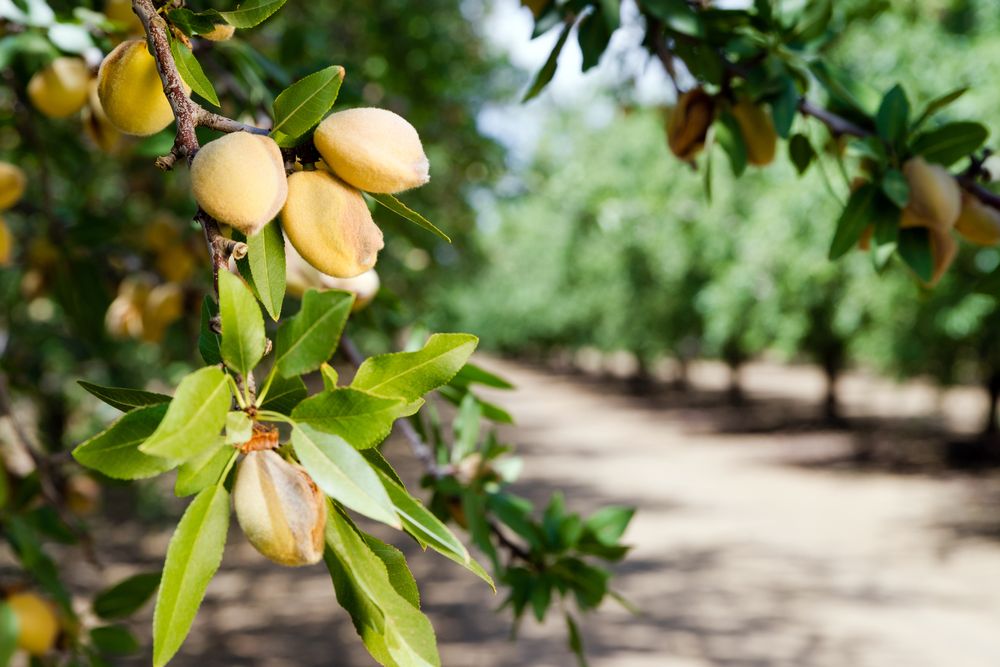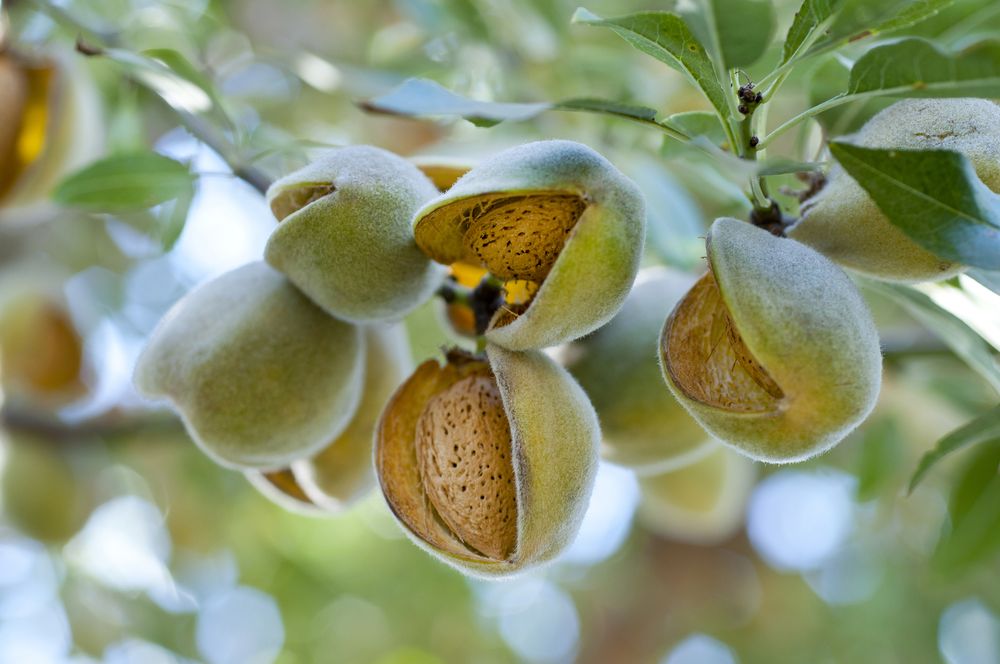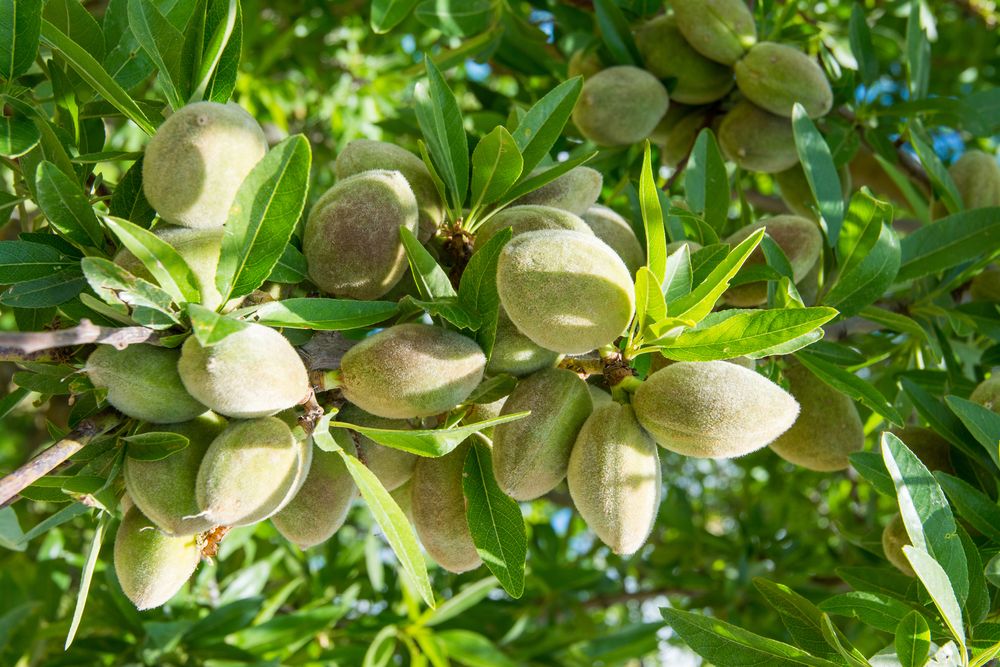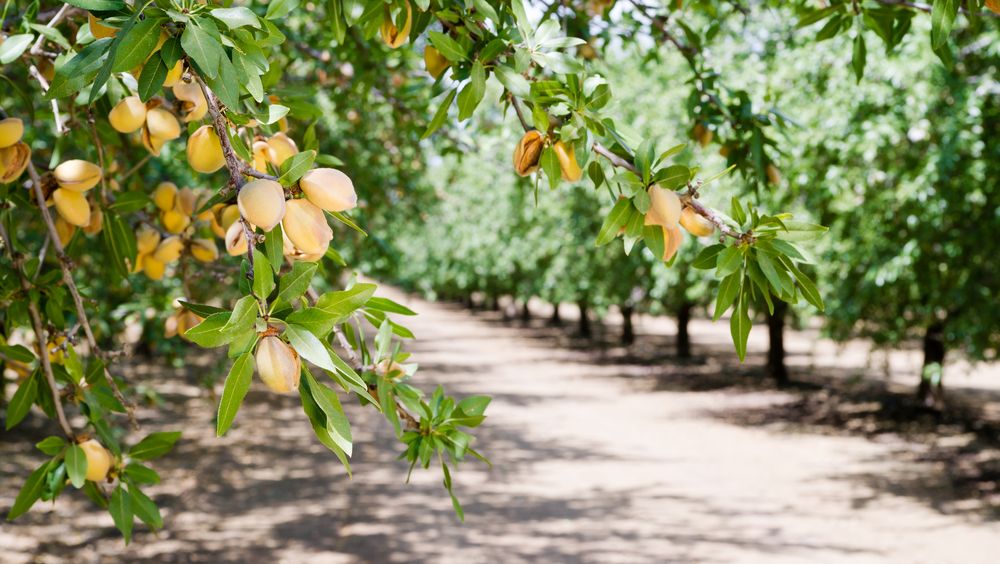Even though the almond tree mainly needs plenty of water to grow and thrive, sometimes growing problems crop up and keep you busy. It’s one thing to have the tree show signs of stress after transplanting. But it’s a totally different matter if the almond tree stops producing flowers or nuts.

Some of the almond growing problems also have to do with winter care. Before the cold winter months, you’ll need to prepare the tree and make sure it will not just survive the cold weather but come back in the spring with an abundance of blooms.
This article deals with the most common growing problems you would face with the almond tree.
Almond Winter Care
The almond tree is a hardy tree that grows well in zones 5 to 9. But the cooler the zone the more preparation you need to do to protect the tree against the winter weather. It doesn’t matter if the tree is young or established.
Lack of winter care can stunt the growth of the tree, causes parts of the canopy to wither and die, and impacts flower and nut production. In severe cases, the roots of the tree might freeze over which spells the end of the tree since there’s no turning back from that one. So how can you prepare the almond tree for the coming winter?
How to Fix It
The two keywords for almond winter care are pruning and shaping. After harvesting the almonds and before the leaves have fallen, that’s when you start preparing the almond tree for the winter.
The tree will often go into dormancy around the time the first frost hits. Select 4 main branches with the smaller branches on them to keep and cut off the rest of the branches. In the spring, new branches will emerge and fill up the canopy. Don’t keep the branches at the same level. Think of it as a scaffolding system. That way you’ll have a healthy and full canopy come next spring.
If you live in cold zones select almond varieties that bloom late in the spring. That way the last frost will not damage the blooms.
Clean all debris and fallen leaves and branches under the tree. They act as hibernating places for pathogens during the winter.
Also part of your winter care includes using sprays on the dormant tree. The sprays will kill all pathogens and fungal spores that hang on the trunk and branches as they wait for the spring to come. Apply the spray again in the early spring before the first blooms.
Rotting Nut Hulls

Some diseases target the blooms or roots of the almond tree. Others are more specific and infect the nuts themselves. In particular, the rotting nut hulls affect the hulls of the nut which reduces the quality of the crop. This fungal disease can spread quickly and move from one tree to the next with catastrophic effects on the whole orchard.
Rhizopus stolonifera is the fungal species responsible for this devastating disease. The worst part is, it’s not easy to detect the signs of the infection until it’s too late. By then most of the almonds would be infected. Sometimes the leaves on the infected branch would wither and die. But it’s easy to overlook this sign and attribute it to something else such as drought.
How to Fix It
The fungal spores usually wait for the nuts to ripen and the hulls to split before they attack. And it’s the water and feeding that attracts them. So if you water your almond tree or fertilize it around the time the nuts are ripening, you could actually be inviting the fungal spores to the tree.
You should reduce the water and stop fertilizing the tree around this time. Make sure that the water stress is slight and doesn’t impact the tree severely, otherwise, this could trigger nut shedding. This defense mechanism is a way for the tree to survive by preserving its dwindling resources.
Botanists recommend a technique called a water bomb. It allows you to measure the moisture in a sample of the tree leaves to know how much water to provide. Make sure the soil doesn’t retain water for long since that will interfere with the water bomb results.
Reduce the nitrogen content in the fertilizer you use. Nitrogen is often behind the spread of the fungal spores that cause the disease.
Container Grown Almond Tree
This might sound hard to believe, but you can really grow the almond tree in a container. You’ll need a large container and increase the watering frequency to keep up with the speed with which potted soil loses moisture. But overall the care tasks are almost identical to growing an almond tree in the garden.
Pruning too will become heavier and more frequent. Even if you have enough space to allow the tree to grow taller, you’d still want it to be compact. This makes it easier for you to care for the tree and move it around.
One other advantage to growing the almond tree in a container is that you can easily take it indoors when the winter comes. This can increase the chances of survival for the tree in zones below 5. If the tree blooms before the last frost, you can protect those blooms until the weather improves then you can take the tree outdoors.
How to Fix It
You will need a container that can hold the tree along with enough soil to keep it growing for at least a year. A 20-gallon container is about the right size for the almond tree. I recommend using a terra cotta pot with plenty of drainage holes at the bottom.
Use a good potting mix or create your own. Mix regular soil with coarse sand at a 1:1 ratio. Fill the pot about 3 inches from the edge with the potting mix and plant the tree in the middle.
Keep the tree in a warm place with the temperature averaging 75 degrees F during the daytime. Avoid drafty windows or open doors that create a cold current. But make sure the tree gets around 8 hours of sunlight. If you don’t get this much sunlight, place a grow lamp close to the pot and turn it on 12 hours a day.
Water the pot thoroughly until excess water flows out of the drainage holes. Allow the top 2 inches of the soil to dry out before you water it again.
No Flowers On Almond Trees

Flowers to fruit trees, almond trees included, are more than ornamental parts of the tree that make it look good. The more flowers you have the more nuts you harvest at the end of the season. But sometimes, the almond tree will not flower at all. Or it might have a few flowers here and there.
This could happen after a high crop the previous year. When the tree produces a lot of nuts one year, the following year it might take a break from the exhausting process of flowering and fruiting altogether.
Pruning also plays a major role in the flowering of the almond tree. Flowers often grow on last year’s branches. So if you delay your pruning to the late fall, winter, or early spring, you could be cutting away the branches that would be carrying flowers this season.
How to Fix It
Start by pruning the tree in the late summer after you have harvested the nuts. Don’t delay it any longer than that since the new branches will not grow flowers that year.
If the tree is having a year off after a big harvest the year before, there’s nothing you can do but to water and feed the tree and let it rest.
Some diseases could prevent the tree from blooming. Look for diseases like blossom blight and fire blight. They cause the flowers to wilt and die before they pollinate. Apply sulfur-based fungicide to treat blossom blight and remove all infected flowers to prevent the spread of the disease.
Finally, make sure the tree is getting enough water. Between one to two inches, a week is the right quota depending on the soil drainage and weather. Drought could cause the tree to drop the flower buds before they open to conserve resources.
Almond Tree Hand Pollination
Bees are the unknown soldiers in the almond industry saga. They pollinate the flowers and ensure that every flower will turn out a delicious nut. But the dwindling bee numbers could translate into poor pollination of the almond flowers. Without pollination, you won’t have a good harvest. Or worse, the nuts might start dropping before they are ripe.
This is the time when you literally have to take matters into your own hands. If the bees fail to show up on time due to heavy rain or simply because your garden is not on their map, then you will have to hand pollinate the almond tree yourself. It’s not an easy task, but with patience, you can get it done.
How to Fix It
The old adage goes, if you want to get something done, do it yourself. So how can you go about pollinating thousands of flowers on a full-grown almond tree?
Start as soon as the flowers open to buy yourself time. Each flower has both the male parts (stamens) and a female part (the pistil). You will need two compatible almond trees that bloom around the same time. And you’ll also need two paintbrushes.
Wait for the pollen to emerge on the stamens and carry it on the paintbrush tip. Go to the neighboring tree and drop some pollen on the bottom of the pistil. One loaded paintbrush can pollinate up to 10 flowers. You just need single pollen resting on the stigma to pollinate the flower.
While you’re still on the second almond tree, brush a second paintbrush with pollen from its flowers and carry them to the flowers of the first tree. Mark the paintbrushes so that you don’t accidentally spread the pollen from the same tree on the flowers.
If that seems like a lot of work, and it sure is, you can plant a self-pollinating almond variety such as Tuono, All-In-One, or Independence.
Almond Tree Not Producing Nuts

Almond trees don’t start flowering and producing nuts right away. You’ll need to wait for up to 4 years before you can get nuts out of the tree. If the tree is still too young, then you know why it’s not producing nuts yet. Just give it time and once you see blooms, you’ll know you’re getting almonds this year for your different dishes and recipes.
But if the tree is flowering in abundance only those flowers don’t produce nuts, then you might have a pollination issue.
A third reason might be the lack of cross-pollination. Most almond varieties need another compatible tree nearby to cross-pollinate the flowers.
How to Fix It
Depending on the cause of the lack of nuts, you will need to take a different action. For young trees, you just have to wait for the tree to turn its fourth year.
If it’s a lack of pollinators, then consider hand pollinating the trees yourself. Or just plant a self-pollinating almond variety.
And last, make sure that you have another almond tree within a 50-foot radius of the first one. And make sure that both trees are compatible to ensure cross-pollination.
The post Almond Growing Problems And How To Deal With Them appeared first on DIYs.com.
Did you miss our previous article...
https://rsssuperfeeds.com/life-hacks/10-luxury-shower-design-ideas






